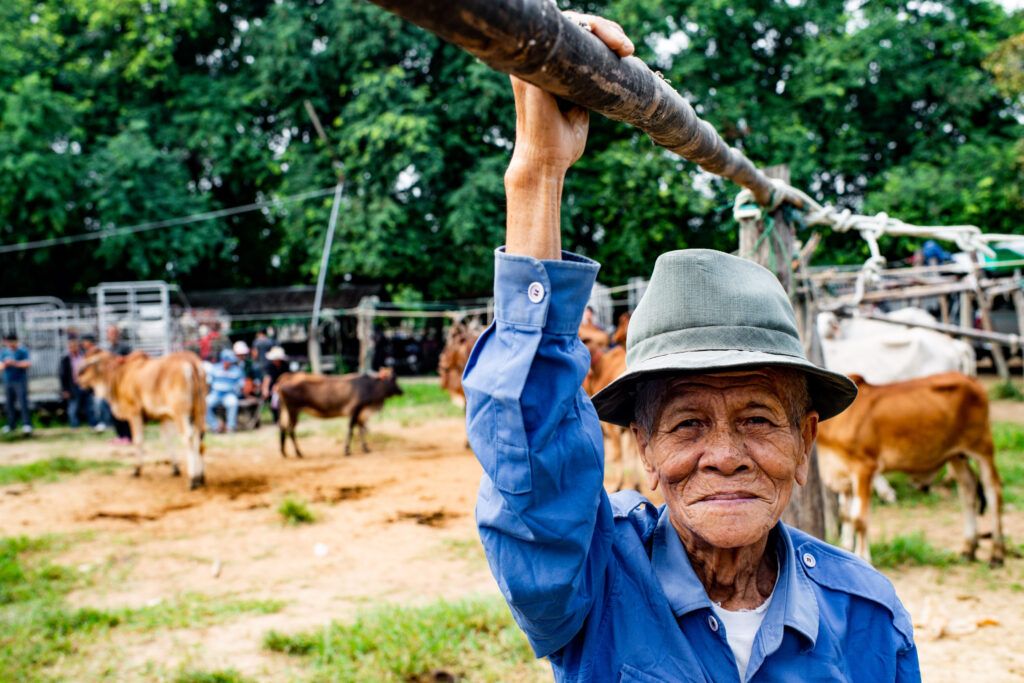Many photographers struggle with one common aspect of taking photos of people. How do you approach a stranger to ask to take their portrait? There’s nothing I can tell you about aperture settings, auto-focus, or any other technical photography skill that will help you with this. Photographing people, whether they are strangers or not, requires different abilities.
I struggled with this as a young photographer. I still do sometimes. As a young man, I was shy and introverted. I loved to photograph many things, but never people. Eventually, my friends started to become part of my photography compositions. But even photographing my friends was challenging for me.
Overcoming the fear of photographing strangers is the first step to capturing great portraits of anyone. This is not an easy thing to do, but it is also not impossible. I have transitioned from being a photographer who never made portraits into one who takes photos that include people in many of them. I also love teaching other photographers how to do this.
Recommended Reading: If you’d like to learn how to create amazing portraits, grab a copy of Photzy’s premium guide: The Art of Portrait Photography.
How to Deal With Your Fear
When you want to make portraits of strangers, the first thing you must learn to do is deal with your fear. The fear of rejection is the most common inhibiting factor that stops people from making portraits of strangers.
Most of the time, this fear is all in your head. If you learn a few techniques about approaching strangers and asking them, you’ll find that the rejections are few. The first thing you need to do is stop these negative thoughts from controlling what you do. Or don’t do it.

Photograph by Kevin Landwer-Johan
Tell yourself to remain positive. If the negative thoughts about being rejected remain in your head, you will project a negative feeling when you do approach people. Your facial expression and body language must be as positive as possible for you to be successful when you want to photograph strangers.
Your facial expression and body language must be as positive as possible for you to be successful when you want to photograph strangers.
Learn to control your thoughts by replacing negative thoughts with positive ones. Some people find it helpful to have a kind of mantra they can repeat when negative thoughts invade their minds.
Practice is the best way to achieve having a clear and positive mind. It may not happen easily, but it is essential to being a successful portrait photographer.
Key Lesson: With a head full of positive thoughts, you’ll feel more confident. When you do approach strangers, your body language and expressions will be warm and welcoming. This is the first step towards your success.
Be Mindful of Your Body Language and Energy
Think about how you respond to negative people. Someone approaching you with a hesitant and negative attitude will not endear themselves to you. Often you will recognize a negative person before they even open their mouth to speak.
When you talk with someone, they notice your facial expressions and body language. Even if they are not consciously aware of it, people sense your energy.

Photograph by Kevin Landwer-Johan
Approaching people with a positive attitude is reflected in your body language and expression. People sensing your positivity are more likely to respond affirmatively. This not only means they are more likely to say yes to your request, but it also means they too will have a positive expression.
When your body language and expression are open and positive, the people you ask will often reflect this to you. Your warm expression will be reflected in you like a mirror.
At first, this will be quite challenging for many people, but as you work on being positive, your anxiety fades away, especially when you have some positive experiences.
Think About Making a Portrait Rather Than Taking a Photo
Between the words ‘making’ and ‘taking,’ there is a subtle difference when considering photos.
Thinking about taking something is not the same as thinking about making something. When you make something, you can give it to someone. Make a portrait and it can become a connection between you and your subject. This small adjustment of thinking goes a long way to maintaining a positive attitude.
I teach photography workshops in Thailand. People who join these workshops often express their desire to want to photograph people. They also talk to me about their fears and how their anxieties prevent them from taking portraits. The most common fear is simply that they do not want to impose on the people they’d like to photograph.

Photograph by Kevin Landwer-Johan
Once you change your thinking about taking a photo to make a portrait, it can help you overcome this negative thought. Many people love being photographed. Some people will even enjoy the experience even if they are a bit shy and hesitant about you wanting to make their portrait. One of the key things that will help you become successful in developing a positive attitude.
Approach each stranger you want to photograph with an open mind and a positive attitude. Be confident that the experience you will both have will make each other’s day better. Many people will enjoy the interaction you’ll have. They will appreciate that you have noticed them and taken the time to connect with them.
Key Lesson: Having a positive mindset toward photographing strangers is both the most difficult and the most important. Develop the understanding that you are giving rather than taking and you will be successful.
Use Your Camera as a Bridge
When I have a camera in my hands, I find it much less challenging to talk to someone, particularly when I want to make their portrait. I like to think of my camera as a bridge between us. It’s what helps me to make connections.
Without a camera, I may have no reason at all to talk with a stranger in the streets. Having a camera and an idea for a portrait photo makes all the difference. Starting, I also had a very good incentive to photograph people.
Here’s my disclaimer: I wanted to keep my job.

Photograph by Kevin Landwer-Johan
I’d landed a job working as the Illustrations Department Assistant at the Auckland Star newspaper. This was back in the 1980s. The building we worked in was old. As the presses were fired up downstairs, we knew about it because the whole building shook.
I assisted the picture editors and worked with the ten photojournalists. It was called the Illustrations Department because the job photographers had was to illustrate the stories that journalists wrote. I learned quickly that most photos appearing in the newspaper had at least one person in them.
My boss would sometimes assign me simple photography assignments. I knew I had to come back with a photo every time, otherwise, I would not keep my job for long. Coming back and telling him I was too shy to make a portrait of a stranger would not cut it. I loved working at the newspaper and wanted to be promoted, so I had to overcome my fears of talking to strangers and photographing them.
Key Lesson: My camera was my bridge. It was my perfect reason to photograph people. Wanting to keep my job and progress as a photographer was my motivation. I slowly began to become less uncomfortable with photographing strangers.
Recommended Reading: If you’d like to learn how to create amazing portraits, grab a copy of Photzy’s premium guide: The Art of Portrait Photography.
Be Determined — Don’t Make Excuses
Overcoming fear requires perseverance. The more excuses you make for not photographing strangers, the more difficult it is to succeed. You need to be determined and set yourself goals if you want to learn anything.
Overcoming fear requires perseverance. The more excuses you make for not photographing strangers, the more difficult it is to succeed.
I had to return to my picture editor from each assignment with at least one publishable picture. This was certainly motivating. Most people will not have this incentive. I am sure my progress in learning to photograph people would have been far slower if my job was not on the line.
I was successful in my goal of having a career in photography, but it did not happen without a lot of hard work mixed with far too much anxiety.

Photograph by Kevin Landwer-Johan
Setting yourself some goals can help you learn to photograph people. One of the most helpful things you can do on your way to success is to start a project to make portraits of strangers.
Make some realistic, but not too easy, goals – whatever you can that will help you get started. It might even be to photograph people you know to start with. This is how I started photographing people before I worked in the newspaper. Think about how many photos of people you’d like to make and give yourself a deadline. Then go to it.
One of the most helpful things you can do on your way to success is to start a project to make portraits of strangers.
Once you have practiced taking photographs of friends and family for a while, rethink your goals. Begin to include photographing strangers in your mix. You don’t have to go out into the street and begin stopping people. You can try making portraits of people you don’t know at school or in your workplace. Sports clubs, religious gatherings, and social hangouts are all also places you can try. If you already feel comfortable in places like this, it will not be so uncomfortable for you.
Key Lesson: Have realistic expectations. Start out knowing that you will feel uncomfortable, but focus on practicing with a positive attitude, and, in time, photographing strangers will become fun.
Develop an Introduction to Go With Your Question
Being prepared with an introduction and a short speech about what you are doing help. When you approach a stranger, wear a nice smile and have something interesting to say to them. If you simply come straight out and ask if you can take a photo, you will probably receive more rejections.
Not only will having a project to work on help keep you motivated, but you can tell people about it. Introducing yourself and telling a stranger why you’d like to take their photo works well. You can simply tell people you are working on a project to help you become better at photographing strangers.

Photograph by Kevin Landwer-Johan
Show an interest in who they are. Pay them a compliment. What about the person who caught your eye? Why were you attracted to them? Tell them as this will help give them some context and confidence in what you are doing.
Once you have greeted a person and asked if you can photograph them, be ready. Have your camera set and ready to go. Make sure your exposure is going to be good and that the person is in focus. If you hesitate, you may miss the moment.
Capturing the Moment

Photograph by Kevin Landwer-Johan
At the local fresh market one day I spotted a porter waiting for a customer. He was standing leaning on his cart. He had interesting tattoos on his arms and was in front of a nice dark background. I was across the narrow street and a short distance from him.
Without drawing attention to myself, I took an exposure reading and set my aperture and shutter speed. I adjusted my focus so the autofocus was at about the right distance. With my 35mm lens on my camera, I knew approximately how close I’d need to be to him for a nice portrait. I also knew that if he agreed to let me make his portrait that I’d need to be quick.
The man appeared to be a bit shy and I knew there was a high likelihood that vendors nearby would start to tease him if they saw me photographing him.
With everything set, I wandered across and asked if I could photograph him. He nodded in agreement, but as he did this, he put his arms down at his side. I quickly asked him to put them back resting on his cart and told him I wanted to see his tattoos in the photo. (The shape of his arms resting on the cart looked great too.)

As this happened, predictably two vendors started to tell him to smile for me. I captured a single frame before he became too embarrassed and pushed his cart away laughing. I managed to grab one frame before he moved, and I the other two I took as he was walking away.

Photograph by Kevin Landwer-Johan
The next time I was at the market I found him again and gave him the one picture that worked out. This was about six years ago and each time I see him he always greets me with a smile. I am sure that had I not prepared my camera and not approached him with a smile, I would not have captured even one good picture of him.
Conclusion

Photograph by Kevin Landwer-Johan
Asking a stranger if you can make a portrait of them becomes easier the more you practice. What you need is lots of experience, and that only happens one way. You have to get out and start approaching people.
Use what you have learned from this guide. Develop your own way of connecting with people. Positively present yourself and be natural. At first, this takes a lot of courage, but the more you practice, the better you’ll get.
No matter how practiced you become in approaching people, you must always have your camera ready. Always expect that you will have a narrow window of time when someone says yes. At this moment you don’t want to be fiddling with your camera settings. Be well prepared so you can keep the flow of conversation going and capture wonderful portraits.

Photograph by Kevin Landwer-Johan
Recommended Reading: If you’d like to learn how to create amazing portraits, grab a copy of Photzy’s premium guide: The Art of Portrait Photography.
Self-Check Quiz:
- What is the first step you need to take to start making great portraits?
- What is the most common inhibiting factor that stops people from making portraits of strangers?
- What will help you feel more confident when you want to photograph strangers?
- Are your facial expressions and body language important aspects when you want to make portraits of strangers?
- What can you use as a bridge to help you connect with people you want to photograph?
- When you first try to photograph strangers, will it be fun?
- List three or more things you can do that will help you connect well with a person you want to make a portrait of.
- Do you need to have your camera set and ready to go when you approach a stranger you want to photograph?














